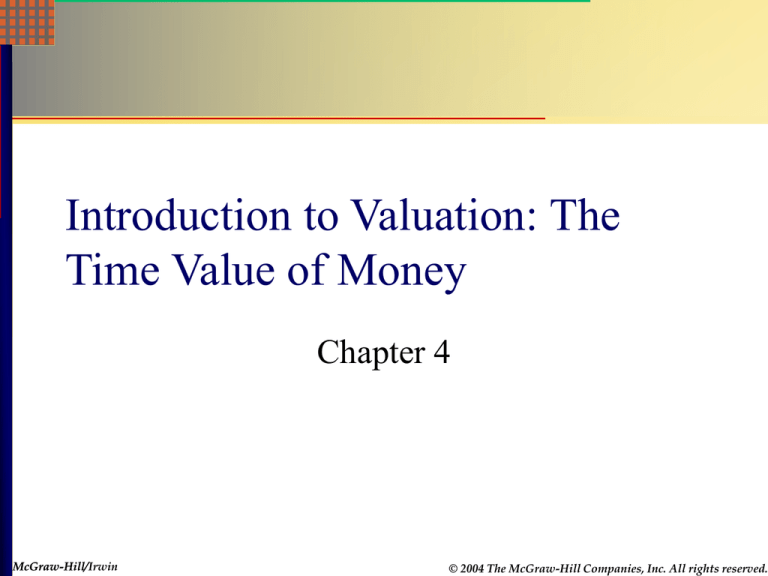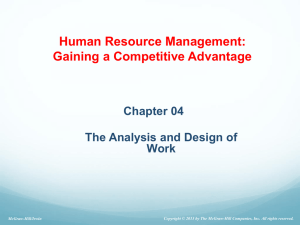
Introduction to Valuation: The
Time Value of Money
Chapter 4
McGraw-Hill
McGraw-Hill/Irwin
© 2004 The McGraw-Hill Companies, Inc. All rights reserved.
Prepare for Capital Budgeting
Part 2: Understand financial statement and cash flow
C2-Identify cash flow from financial statement
C3-Financial statement and comparison
Part 3: Valuation of future cash flow
C4-Basic concepts
C5-More exercise
Part 4: Valuing stocks and bonds
C6-Bond
C7-Stock
Part 5: Capital budgeting
4.1
McGraw-Hill
McGraw-Hill/Irwin
© 2004 The McGraw-Hill Companies, Inc. All rights reserved.
Chapter Outline
1.
2.
3.
4.
5.
Future Values: Definitions and Formula
Present Values
PV – Important Relationship
Calculate Rates and Number of Periods
Calculator Keys
4.2
McGraw-Hill
McGraw-Hill/Irwin
© 2004 The McGraw-Hill Companies, Inc. All rights reserved.
1. Example
Suppose you put $5000 in bank for one year at 3%
interest rate per year. What is the value of your
money in one year?
Interest = 5000(.03) = 150
Value in one year = principal + interest
= 5000+5000(.03) = 5000 + 150 = 5150
= 5000(1 + .03) = 5150
Suppose you leave the money in for another year.
How much will you have two years from now?
FV = [5000(1.03)](1.03)
= 5000(1.03)2 = 5304.5
4.3
McGraw-Hill
McGraw-Hill/Irwin
© 2004 The McGraw-Hill Companies, Inc. All rights reserved.
Example (cont..)
1 year: Value = 5000(1+.03)
2 years: Value = [5000(1+.03)](1+.03)
3 years:
Value = {[5000(1+.03)](1+.03)} (1+.03)
4 years: Value =
{{[5000(1+.03)](1+.03)} (1+.03)} (1+.03)
4.4
McGraw-Hill
McGraw-Hill/Irwin
© 2004 The McGraw-Hill Companies, Inc. All rights reserved.
Example (cont..)
1 year: Value = 5000(1+.03)
= 5000(1+.03)1
2 years: Value = [5000(1+.03)](1+.03)
= 5000(1+.03)2
3 years:
Value = {[5000(1+.03)](1+.03)} (1+.03)
= 5000(1+.03)3
4 years: Value =
{{[5000(1+.03)](1+.03)} (1+.03)} (1+.03)
= 5000(1+.03)4
4.5
McGraw-Hill
McGraw-Hill/Irwin
© 2004 The McGraw-Hill Companies, Inc. All rights reserved.
Basic Definitions
FV = PV(1 + r)t
Present Value – earlier money on a time line
Future Value – later money on a time line
Interest rate – “exchange rate” between earlier money
and later money
Discount rate
Cost of capital
Opportunity cost of capital
Required return
Time value of money: A dollar in hand today is worth
more than a dollar promised at some time in the future.
4.6
McGraw-Hill
McGraw-Hill/Irwin
© 2004 The McGraw-Hill Companies, Inc. All rights reserved.
Future Values: General Formula
FV
= PV(1 + r)t
FV = future value
PV = present value
r = period interest rate
T = number of periods
Future
value factor = (1 + r)t
4.7
McGraw-Hill
McGraw-Hill/Irwin
© 2004 The McGraw-Hill Companies, Inc. All rights reserved.
Effects of Compounding
Compounding:
the process of accumulating
interest over time to earn more interest.
Compound interest: interest earned on both the
initial principal and the interest earned from
prior periods.
Compound interest (total interest)
=Simple interest+Interest on interest
Simple interest: interest on principal
4.8
McGraw-Hill
McGraw-Hill/Irwin
© 2004 The McGraw-Hill Companies, Inc. All rights reserved.
Illustration on Compounding
2004
2005
2006
2007
$5000
$5150
$5304.5
Interest earned (2004-2005)=$150
$150
Interest earned (2004-2006)=150+(150+4.5)=$304.5
$150
$4.5
$150
4.9
McGraw-Hill
McGraw-Hill/Irwin
© 2004 The McGraw-Hill Companies, Inc. All rights reserved.
Illustration on Compounding (cont..)
2004
2005
$5000
$5150
2006
$5304.5
2007
$5463.6
Interest earned (04-06)=150+(150+4.5)=$304.5
Interest earned(04-07)=150+(150+4.5)+(150+9.1)=$463.6
$150
$4.5
$9.1
$150
$150
Compounding effect=Total interest earned - simple interest
=463.6 – 150 – 150 – 150 = 463.6 - 3(150) = 13.6
4.10
McGraw-Hill
McGraw-Hill/Irwin
© 2004 The McGraw-Hill Companies, Inc. All rights reserved.
Figure 4.1
4.11
McGraw-Hill
McGraw-Hill/Irwin
© 2004 The McGraw-Hill Companies, Inc. All rights reserved.
Future Values – Example
Suppose you had a relative deposit $10 at 5.5% interest
200 years ago. How much would the investment be
worth today?
FV = 10(1.055)200 = 447,189.84
What is the effect of compounding?
Total interest = FV- PV = 447, 179.84
Simple interest = 200[(10)(.055)] = 110
Compounding effect = Total interest – simple interest
= 447,179.84 -110= 447,069.84
Compounding has added $447,069.84 to the value of the
investment.
4.12
McGraw-Hill
McGraw-Hill/Irwin
© 2004 The McGraw-Hill Companies, Inc. All rights reserved.
2. Present Values
How much do I have to invest today to have some
amount in the future?
FV = PV(1 + r)t
Rearrange to solve for PV = FV / (1 + r)t
Present Value factor (Discount factor)= 1 / (1 + r)t
When we talk about discounting, we mean finding the
present value of some future amount.
When we just say the “value” of something, we are
talking about the present value unless we specifically
indicate that we want the future value.
4.13
McGraw-Hill
McGraw-Hill/Irwin
© 2004 The McGraw-Hill Companies, Inc. All rights reserved.
Example
If you want to have $5000 in your account this year,
how much you should put in the bank last year
given 3% interest rate per year?
(last year) vs.
(this year)
PV= 5000/(1+3%) = $4854
4.14
McGraw-Hill
McGraw-Hill/Irwin
© 2004 The McGraw-Hill Companies, Inc. All rights reserved.
PV –Example
Suppose
your grandmother know you need
$2500 in one year for car down payment. If you
can earn 3% quarterly interest when put the
money in the bank, how much does she need to
give you today?
PV = 2500 / (1.03)4 = 2221.2
4.15
McGraw-Hill
McGraw-Hill/Irwin
© 2004 The McGraw-Hill Companies, Inc. All rights reserved.
3. PV – Important Relationship I
For a given interest rate and future value – the longer
the time period, the lower the present value
What is the present value of $500 to be received in
5 years? 10 years? The discount rate is 10%
5 years: PV = 500 / (1.1)5 = 310.46
10 years: PV = 500 / (1.1)10 = 192.77
Future Value=Present Value+Interest Earned
PV = FV / (1 + r)t
4.16
McGraw-Hill
McGraw-Hill/Irwin
© 2004 The McGraw-Hill Companies, Inc. All rights reserved.
PV – Important Relationship II
For a given time period and future value – the higher
the interest rate, the smaller the present value
What is the present value of $500 received in 5
years if the interest rate is 10%? 15%?
Rate = 10%: PV = 500 / (1.1)5 = 310.46
Rate = 15%; PV = 500 / (1.15)5 = 248.58
Future Value=Present Value+Interest Earned
PV = FV / (1 + r)t
4.17
McGraw-Hill
McGraw-Hill/Irwin
© 2004 The McGraw-Hill Companies, Inc. All rights reserved.
4. The Basic PV Equation Refresher
= FV / (1 + r)t
There are four parts to this equation
PV
PV,
FV, r and t
If we know any three, we can solve for the
fourth
4.18
McGraw-Hill
McGraw-Hill/Irwin
© 2004 The McGraw-Hill Companies, Inc. All rights reserved.
Discount Rate
Often
we will want to know what the implied
interest rate is in an investment
Rearrange the basic PV equation and solve for r
FV = PV(1 + r)t
r = (FV / PV)1/t – 1
If
you are using formulas, you will want to
make use of both the yx and the 1/x keys
4.19
McGraw-Hill
McGraw-Hill/Irwin
© 2004 The McGraw-Hill Companies, Inc. All rights reserved.
Discount Rate – Example
You
are looking at an investment that will pay
$1200 in 5 years if you invest $1000 today.
What is the implied rate of interest?
r = (1200 / 1000)1/5 – 1 = .03714 = 3.714%
4.20
McGraw-Hill
McGraw-Hill/Irwin
© 2004 The McGraw-Hill Companies, Inc. All rights reserved.
6. Calculator Keys
Texas
Instruments BA-II Plus
FV = future value
PV = present value
I/Y = period interest rate
Interest is entered as a percent, not a decimal
N = number of periods
Remember to clear the registers (CLR TVM) after
each problem
Other calculators are similar in format
4.21
McGraw-Hill
McGraw-Hill/Irwin
© 2004 The McGraw-Hill Companies, Inc. All rights reserved.
Calculator Settings (Appendix D)
Compounding
frequency
Set P/Y=1: Press [2 nd] [I/Y] (P/Y), show {P/Y},
[1] [ENTER]
Set C/Y=1: [ ] [1] [ENTER] [2 nd] [CPT] (QUIT)
End
mode and annuities due
Start with [2 nd] [PMT] (BGN)
Switch between END and BGN using [2 nd]
[ENTER] (SET)
End with [2 nd] [CPT] (QUIT)
4.22
McGraw-Hill
McGraw-Hill/Irwin
© 2004 The McGraw-Hill Companies, Inc. All rights reserved.
Future Values – Example 1
Suppose you invest $1000 for 5 years with 5% interest
rate. How much would you have at the end of 5th year?
FV = 1000(1.05)5 = 1276.28
Calculator:
N = 5; I/Y = 5; PV = 1000;
CPT FV = -1276.28
4.23
McGraw-Hill
McGraw-Hill/Irwin
© 2004 The McGraw-Hill Companies, Inc. All rights reserved.
Present Value – Example 1
Suppose your grandmother know you need $2500 in
one year for car down payment. If you can earn 3%
quarterly when put the money in the bank, how much
does she need to give you today?
PV = 2500 / (1.03)4 = 2221.2
Calculator
N=4
I/Y=3
FV=2500
CPT PV = -2221.2
4.24
McGraw-Hill
McGraw-Hill/Irwin
© 2004 The McGraw-Hill Companies, Inc. All rights reserved.
Using Financial Calculator
When
using a financial calculator, be sure and
remember the sign convention or you will
receive an error when solving for r or t
4.25
McGraw-Hill
McGraw-Hill/Irwin
© 2004 The McGraw-Hill Companies, Inc. All rights reserved.
Discount Rate – Example 1
You
are looking at an investment that will pay
$1200 in 5 years if you invest $1000 today.
What is the implied rate of interest?
r = (1200 / 1000)1/5 – 1 = .03714 = 3.714%
Calculator – the sign convention matters!!!
N=5
PV = -1000 (you pay 1000 today)
FV = 1200 (you receive 1200 in 5 years)
CPT I/Y = 3.714 (%)
4.26
McGraw-Hill
McGraw-Hill/Irwin
© 2004 The McGraw-Hill Companies, Inc. All rights reserved.
Number of Periods – Example 1
You
want to purchase a new car and you are
willing to pay $20,000. If you can invest at 10%
per year and you currently have $15,000, how
long will it be before you have enough money
to pay cash for the car?
Calculator:
I/Y = 10; FV = 20,000; PV = -15,000;
CPT N = 3.02 years
4.27
McGraw-Hill
McGraw-Hill/Irwin
© 2004 The McGraw-Hill Companies, Inc. All rights reserved.
Review Questions
1.
Know how to calculate the future value, present
value, and rate of return of an investment.
What is the difference between simple interest
and compound interest? How to calculate
compounding effect?
What is a compounding process and what is a
discounting process?
4.28
McGraw-Hill
McGraw-Hill/Irwin
© 2004 The McGraw-Hill Companies, Inc. All rights reserved.
Review Questions (cont..)
3.
How will discount factor and future value factor
change with the interest rate and length of time?
As you increase the length of time involved,
what happens to FV for a given PV and rate?
What happens to PV for a given FV and rate?
If you increase the rate, what happens to FV for a
given PV and time length? What happens to PV
for a given FV and time length?
4.29
McGraw-Hill
McGraw-Hill/Irwin
© 2004 The McGraw-Hill Companies, Inc. All rights reserved.









